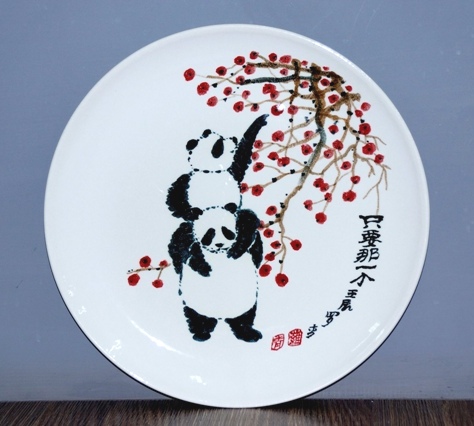羅 青 墨彩 / 陶瓷畫展: 貓熊之歌
The Art of Lo Ch’ing: Songs of Panda
99’ 藝術中心 99 Art Center Taipei
Date: 2012 年 7 月 14 -29 日
Venue: 台北市敦化南路一段 259 號 5 樓
Tel: 2700-3099 Email: 99dac@99dac.com
開幕酒會: 7 月 14 日 (星期六) 下午 3:00
Reception: July 14, 3: 00 PM
貓熊:儒家君子新象徵
羅 青/文
繼1961年《世界自然基金會》以熊貓為會徽,
此後,熊貓標誌成了全世界廣受大人小孩歡迎的寵物意象,
事實上熊貓性屬孤獨宅男,一年只有在交配期間,才與雌性同居,
在中國古神話中,熊貓名為貔貅,是威猛勇士,也是反戰份子。《尚
在其他古籍中,熊貓展現出另一種特質。東方朔《神異經》說:「南方有獸,名曰齧鐵。」,指的就是熊貓。晉 郭璞注《爾雅·釋獸》提及熊貓,也說它:「似熊、小頭、痹腳、
「熊貓」 此一荒謬的現代名稱,顯示此物一進入二十世紀,
自古至今,除了象徵儒家聖王賢能的神龍之外,
時至二十一世紀的今日,該是讓熊貓加入吉祥瑞獸傳統的時候了,
熊貓的可愛形象,多半來自小熊貓,其中蘊含卡通式的輕鬆與幽默,
Panda, A Pensive Confucian Gentleman of our Times
By Lo Ch’ing
Following the World Wildlife Fund’s (WWF) employing the image of panda as its logo in the early 60s in order to awaken the awareness of conservation and the conscientiousness of environmental protection, Beijing began to send real pandas touring globally as Goodwill Ambassadors in the beginning of the 70s, consequently turning the endangered species into the icon of a friendlier China.
Welcomed and beloved by children and adults alike around the world, the image of panda has become very popular and sometimes excessively propagated as to be overused both politically and commercially to the point of skin-deep gaudiness, naïve shallowness blended with cheap clown like sweetness. Its true tragic role with contradictory mythological attributions as an extinguished wildlife animal has almost completely passed into oblivion.
The truth is that the male panda who will only take and keep a female company shortly during the mating season within a period of one month is rather of a type of gentle and lonely bachelor. It often lives quietly by the meandering brooks and saunters pensively among the bamboos, its regular diet, like a genuine gentleman recluse praised by Confucius, who regarded bamboo as the proper symbol of a decent upright personality staying fresh and green against bitter and hostile weathers even in the midst of heavy snow.
In ancient Chinese mythology, panda called by the name of Pi-xio (貔貅) was both a warrior and a pacifist. It often dashed with tiger, bear and elephant in the battle field to assist generals and soldiers to defeat the invading enemies. After the war was won, comfortably and nonchalantly would it retire into the mountains eating metals or weapons for a living. It was believed that his urinate could melt needles swallowed and stuck in the throat by accident. Panda, therefore, was also addressed as Zou-yu (騶虞), the animal of righteousness in the Book of History (史記). Warriors enjoyed wearing its skin to show bravery and its image was frequently painted on the flag used as a truce token.
The somewhat ridiculous modern Chinese name of panda, Xiong-mao (熊貓), literally meaning “Bear-cat” proves the poor creature was also a helpless victim of the abuse of modern media. In the 40s during the period of world War II, a stuffed panda was for the first time displayed to the public at the Museum of Chung-qing with a caption read Moa-xiong (貓熊 literally cat-bear) and it was misread by a young journalist who published its photo by labeling it with the following two characters Xiong-mao (熊貓). Soon, the wrong and confusing title had been widely circulated and accepted and people began to address the animal Xiong-mao regardless of its correct genuine scientific name. From then on, panda has suffered a dissociation of sensibility, its name deconstructed from its nature and its form no longer the echo of its content.
Besides the mythological dragon, the symbol of sage king and cultural saint, the horse, the mundane transformation of a dragon, the symbol of bravery and enterprise, has been the most popular model animal for artists ancient and modern to depict passionately and portray devotedly on stones, bronzes and murals to begin with and later on silk, satin and paper from the ancient time to the present. After Tang dynasty, new propitious animals were added into the graphic beneficial imagery repertoire, just to name a few as examples: the crane, brushed as symbol of congratulation and immortality, the peacock royalty and richness, the quails peace and harmony, the fishes abundance and surplus, the monkey high rank marquis, the sheep and the goat lucky and auspiciousness, the elephant washing ushering fresh vision with new hope, the butterfly and the cat longevity and seniority, the tiger austerity and dignity, the lions teacher-students continuity.
Now it is time to add panda into the time-honored list of auspicious model animals with new theme, significance and concept. While the adult panda could continue to play the traditional role of a musing Confucian gentleman or a meditating Buddhist Dharma, sophisticated, idealistic and tragic, it also could acquire new roles such as a conservationist, environmentalist and wildlife protector, exercising its duty as a social critic or political commentator to reflect fully and poignantly diverse contemporary cultural concerns and problems.
As for the cute little cubs, they could play their cartoon roles with lightheartedness and good humor entertaining the world of adult and kid at once without even knowing it. Especially when mother panda and its youngsters being together, a perfect loving family picture would and will have impressed into the hearts of countless viewers of the past, present and future.


